
D2H and its benefits
D2H originates from Debt-for-Development (D2D) swaps. It is noteworthy that in the post-World War II era, postcolonial governments in Latin America often generated foreign exchange by exporting ecological resources, such as rubber and timber, despite the region’s simultaneous challenges of ecological catastrophes and debt. In 1984, American academic Thomas Lovejoy proposed a novel concept: a debt-for-nature swap [15]. According to data from national development finance estimates, the debt-for-nature method produced $126 million in local currency between 1987 and 1997 from around $134 million in commercial developing country debt, which was bought at an average discount of 78% [16, 17]. Pilot programs were started in the nations with large sovereign debt loads as a result of this effective strategy. The Economic Commission for Latin America and the Caribbean’s endeavor to implement a debt swap that is climate adaptable since 2017 is one example of the situation in question. This plan uses a debt swap model similar to Belize’s to lower the debt of three pilot countries by $527 million through the issuing of green bonds.
D2H is viewed as a subset of debt-for-sustainable development since it has proven to be effective in reorganizing debt and creating win–win scenarios for the creditor, the debtor nation, and a third party acting as an intermediate health finance organization. Since 2007, the Global Fund to Fight AIDS, Tuberculosis and Malaria (the Global Fund) has demonstrated the effectiveness of debt-to-health (D2H) swaps, and considerable progress has been made in raising more funds for health [18]. Debtor countries pledge to strengthen their health infrastructures or take up measures to fight AIDS, malaria, and tuberculosis, with the support from the Global Fund. These nations are released from their financial responsibilities in exchange from the creditor nations [19]. To date, the Global Fund has channeled investments over 226 million US dollars into debt conversion via D2H in the health sector for over ten countries, including Ethiopia, Egypt, Cameroon, and most notably Indonesia.
-
1.
Generic operating procedure of D2H
A D2H scheme typically consists of four components (Fig. 2): anticipating or identifying potential opportunities for cooperation, planning, implementing, and evaluating. This involves reaching a partial or complete debt relief agreement between the debtor and creditor country through the mediation and coordination of a health financing agency, transferring the relief fund to the debtor country to support a particular health project, and the debtor country fulfilling its obligation to ensure that the relief fund is used appropriately to achieve the agreed-upon outcomes.
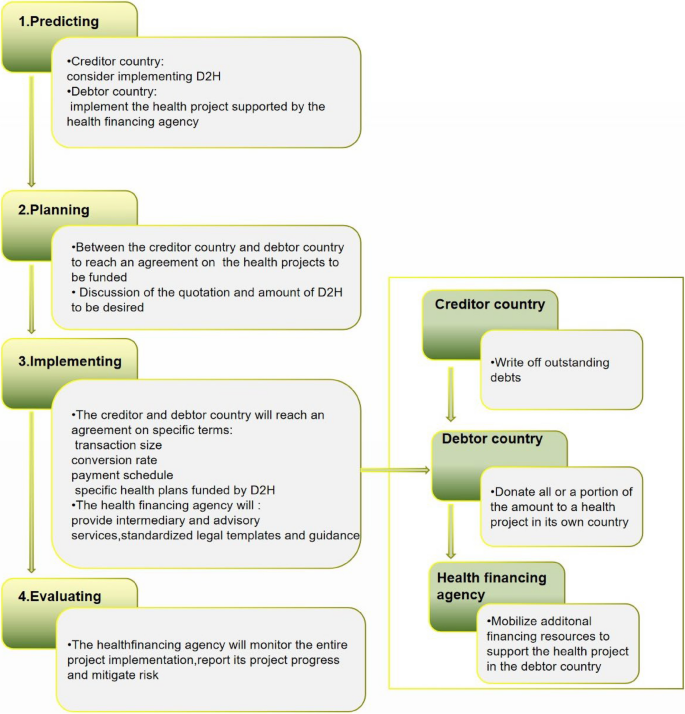
Generic operating procedure of D2H
The intermediary health financing agency monitors the implementation of the health project, promotes transaction between the creditor and debtor country, and conducts administrative management and results reporting for both the creditor and debtor country.
These institutions play a pivotal role as the “hub” of the D2H project. Taking the Global Fund as an example, first, the health financing agency serves as a “multilateral platform” that promotes health system strengthening, the fight against AIDS, tuberculosis, and malaria through multi-country donations and participation of over 100 countries, providing large-scale opportunities for D2H projects. Debtor countries and creditor countries can rely on this platform to negotiate and reach consensus. Secondly, the health financing agency functions as a “savings pool”. The negotiation and signing of agreements for D2H projects can be lengthy, but the Global Fund has a large number of health projects waiting for funding, ensuring that project implementation is not disconnected from capital investment. Finally, the health financing agency serves as a “monitor”. The implementation of D2H projects requires the exclusion of stakeholders. Although the Global Fund is stakeholder-related, its transparency and accountability as a humanitarian platform enable it to have a higher monitoring and evaluation effect, far superior to spontaneous monitoring and evaluation behaviors by debtor countries and creditor countries. The pattern diagram is shown in Fig. 3.
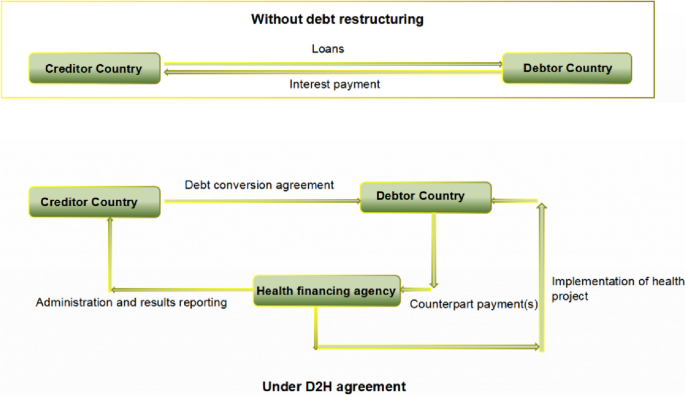
Comparison between the basic model of D2H and regular debt repayment
For instance, the Global Fund oversaw and carried out the Spain-Cameroon D2H project, which made it possible to clearly identify the tasks that each party played. Spain and Cameroon reached a debt reduction deal that resulted in the total cancellation of outstanding obligations of 24.1 million euros. About 40 percent of this total, or 9.3 million euros, came from Cameroon’s donation to the Global Fund, which was then included in the nation’s grant distribution. Through this 2017 agreement, the Global Fund’s allocation for HIV and AIDS in Cameroon was increased to 81.7 million euros, enabling an additional 38,000 people living with HIV (PLHIV) to get antiretroviral medication.
Increasing political resolve to tackle “horizontal” challenges like service delivery and health system strengthening is another important component of the D2H strategy. Eight projects supporting Indonesia, Pakistan, Egypt, Jordan, and Sri Lanka were part of the D2H exchanges between 2007 and 2021, with Germany acting as the creditor and the Global Fund acting as the intermediary. From the Global Fund’s primary focus on major infectious diseases, the building of resilient and sustainable health systems (RSSH) was added to the scope of funding. Concurrently, the recipient program moved from discrete initiatives to a more comprehensive strategy, increasing its engagement in all-encompassing health initiatives [18] (Fig. 4). It should be noted that 2017 is not a turning point, for instance, the prevention and control of tuberculosis continues to be the primary source of funding for D2H projects in Germany and Indonesia beyond 2017.
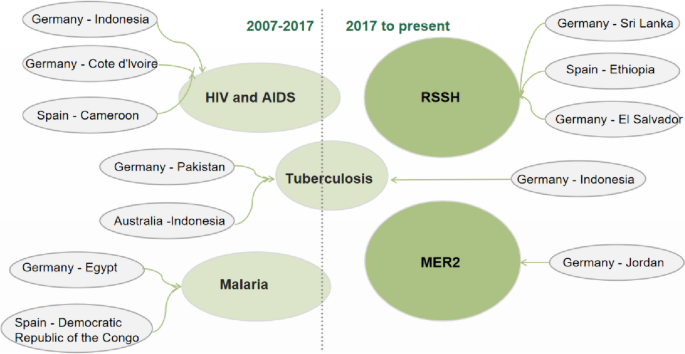
Evolution of D2H facilitated by the Global Fund(RSSH: resilient and sustainable systems for health MER2: The Global Fund’s Middle East Response2 program)
-
2.
Benefits of D2H for different stakeholders
D2H, as a sovereign debt conversion solution, can create a triple win situation by adding value to all involved stakeholders (Fig. 5).
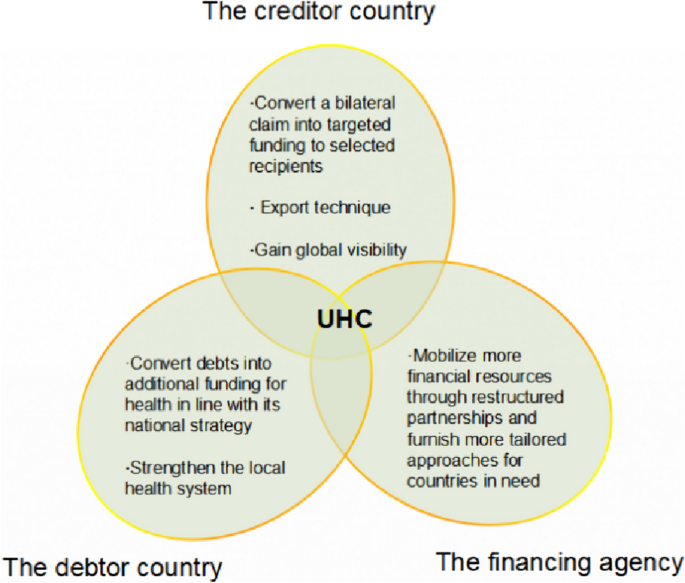
For the creditor country, D2H can serve as an opportunity to promote their own global public goods for health in the developing countries.Particularly considering the significant gaps in funding for health research, the growth of diseases affecting the poor, and the enhancement of epidemic prevention [20]. In particular, creditor nations may better export their human resources in the health sector, and initiatives like technology transfer will help creditor expertise go farther. In the meantime, the creditor nation raises its profile internationally and transforms a bilateral demand into targeted support for particular recipients. As an illustration, the D2H project was launched in 2019 between El Salvador and Germany. El Salvador’s $11 million debt was changed into $11 million for the building of the National Reference Laboratory (LNR) ( lifecycle surveillance of the population, quick response to medical emergencies, and illness diagnosis and monitoring are all greatly aided by the LNR. Beyond just providing financial support, Germany is directly involved in building the LNR as part of this initiative. First, by improving ties with the National Institute of Health, Germany has reinforced technical guidance at the El Salvador LNR. Secondly, more diversified disease detection equipment, including those for rubella, dengue fever, and rabies, has been added in addition to improving conventional equipment for the detection of HIV, malaria, and tuberculosis. Lastly, because D2H has deftly converted sovereign debts into ODA investments, Germany, the largest D2H creditor country at this point, unquestionably maintains its leadership position in both the banking and health sectors [21]. This proves that creditor countries’ gains in D2H initiatives—such as knowledge transfer, product exports, and improved international standing—are real and not just theoretical.
For the debtor country, it converts debts into additional funding for health in line with its national strategy. As seen in Fig. 3 above, there is a clear time breakpoint. Prior to 2017, the three main diseases of AIDS, malaria, and tuberculosis were the only ones receiving worldwide funding for D2H. But when the D2H project was halted and adjusted, the investment areas dramatically grew to include health system strengthening, with the goal of being in line with the nation’s national health plan. The primary goal of the $16 million D2H project funds from Germany and Sri Lanka in 2021 was to reinforce the nation’s quality management system and health information system, in addition to the primary health care strengthening initiatives being carried out by the Asian Development Bank and the World Bank. The areas that the RSSH, which is a macro concept discussed in this article, designates for assistance must be equitably negotiated by the three parties and be in line with the debtor nation’s national health plan. Furthermore, D2H has advanced to the point where vertical and horizontal programs are integrated, which could support the local health system’s strengthening. Using the D2H project between Germany and Sri Lanka in 2021 as an example, the Global Fund approved an emergency fund of US$989,687 in August 2022 to ensure the availability and distribution of necessary drugs and health care services for HIV treatment and prevention throughout Sri Lanka, in addition to strengthening primary health care projects ( Later, to address financial shortfalls for the D2H project, an additional $4 million was supplied under the Global Fund’s COVID-19 response mechanism. In order to better support the SDG targets of debtor countries, the D2H supported horizontal projects gradually complement its vertical projects, which focus on individual infectious diseases.
For the intermediary health financing agency, it will be equipped with an effective instrument to mobilize more financial resources through restructured partnerships and furnish more tailored approaches for countries in need. For instance, increasing funding for initiatives against HIV, TB, malaria, and RSSH through the Global Fund helps save lives. The intermediary health financing agency serves as more of a “hub,” as was previously mentioned. The amount of money given by D2H is insufficient to pay down a nation’s health debt. It emphasizes gradual consequences more so than debt alleviation. D2H’s primary objective is to raise more funds for healthcare, and their influence on health takes precedence above debt reduction.
Gap of the studies of D2H
-
1.
Lack of data collection
As of now, the data we can collect from the Global Fund is as follows (Table 1). It is evident that only the countries of the debtors and creditors, the anticipated investment amount, and the actual amount received are now covered by the D2H data gathered by the Global Fund. We don’t have precise information about how money is used in the health sector. The vast range of D2H programs contributes to the paucity of information regarding their effects on health. Investments in laboratory building and health information systems, for example, produce various indicators related to health outcomes. Similarly, distinct health outcome metrics are produced by investments that target different diseases. There is presently no common system for measuring the many health initiatives that are carried out in different debt-ridden nations, despite the fact that performance evaluations have a major influence on the budget for the upcoming cycle of investments. Furthermore, the health policies of each debtor country influence how transparent D2H initiatives are. The current situation where data is predominantly provided by health financing entities like the Global Fund is the outcome of the intricate relationships among numerous stakeholders. Financial assessments are frequently given precedence over the assessment of protection outcomes in certain D2H programs that are protection-focused. Therefore, oversight by the health financing organization is still necessary to address the problems of data scarcity and lack of openness. Also, under the direction of the health financing organization, debtor and creditor countries should engage in developing precise, open, and mutually agreeable indicator systems and offer concrete data.
-
2.
Lack of summary of lessons learned and adequate evaluation of the project mechanism and impact
Both qualitative and quantitative methodologies must be used in tandem to create a thorough evaluation system for the D2H project. A thorough examination of the project’s effective components and underlying logic can be achieved through qualitative evaluation, which can also yield valuable insights for project optimization. A more objective and accurate representation of the project’s operational effectiveness can be achieved through quantitative evaluation, which is grounded on data and offers a more scientific foundation for decision-making.
Qualitatively, there isn’t a summary of the D2H project’s past successes as an endeavor. Conducting a methodical survey of designers, implementers, and evaluators is necessary for this. The D2H mechanism can be further optimized and improved by following the overview of successful D2H experiences. Quantitatively, a data-driven evaluation plan is necessary for the whole D2H project phase. There are four stages for the quantitative evaluation. The first step, known as the feasibility review, calls for debtor and creditor countries as well as the health financing organization to evaluate the available funds, how they will be used, and when they will be disbursed. The second phase, known as process assessment, evaluates the elements that drive project execution, such as resource allocation, policy environment, and implementation efficiency. Impact evaluation, the third step, evaluates the project’s actual operational effectiveness in terms of illness control, health improvement, and economic impact. The project’s long-term stability and sustainability are primarily evaluated in the fourth stage, sustainability evaluation, which also determines whether more funding or policy assistance is required.
Typical features and factor for a successful D2H
Through scoping review and expert interview, we can summarize some typical features of D2H:
-
1.
A strong political will
The most important element influencing D2H’s effectiveness is the political will of both the creditor and debtor nations. The following factors are typically seen to be essential when choosing a debt reduction option:1). The global political debt relief decisions may be hampered by strained international relations, which could erode the political will of both debtor and creditor countries [22] 2). Debtor countries’ economic circumstances: Making decisions also requires consideration of the debtor countries’ economic circumstances. Political authorities may be more receptive to debt relief if the debtor country’s economy is in decline and it has little budgetary room for SDG-related expenditures. 3). The creditor countries’ readiness: It is reasonable to expect creditor countries to support debt reduction, and this is one of the deciding criteria as well [23]. 4). The Global Fund and other health financing organizations play a crucial leadership and coordination role in advancing D2H by bringing together the governments of the debtor and creditor countries to facilitate negotiations and ultimately lead to a mutual agreement. In other words, sincere respect for and consideration of the political goals of all participating nations are necessary for making programs successful. D2H projects also need to be assessed from a number of angles, including political dynamics, credit ratings, the debtor nation’s foreign debt policies, its capacity for implementation, and the supervision and coordination of the third party during the entire undertaking.
-
2.
Debt transparency as an essential prerequisite
The international community is acutely aware of the necessity of debt transparency, as demonstrated by the “Tuna Bond” episode in Mozambique, which underlines the dangers of inadequate debt transparency [24]. In order for D2H schemes to be configured, debt transparency is required. This helps evaluate whether debt relief is required by giving all involved parties a clear image of the outstanding debts, risks of debt default, and the status of fiscal incomes and expenditures. Without openness, donor nations may find it difficult to formulate a sensible plan to assist recipient nations in reducing their debt load, which could lead to agreements that are untrustworthy or deceptive. Debt transparency has been shown to improve how money is allocated and used, protect against financial errors, and stop resources from being abused or wasted. Transparency in debt can guarantee that D2H financing is directed toward high-priority areas through well-managed and supervised projects. Moreover, debt transparency will boost investors’ confidence in making long-term investments by improving their capacity to recognize particular projects and manage risks.
-
3.
Administrative changes pose a burden on both parties
The complete integration of financial, material, and human resources is necessary for the successful deployment of D2H. These could include: 1). The debtor country must set aside money for D2H in order to ensure prudent fund management and focused investments. 2). The debtor country should conduct initial evaluations to determine the project’s feasibility and dangers, as well as to describe the investment plan and expected financial gains. 3). Establishing a strong oversight system, keeping a close eye on the project’s development, and quickly identifying post-project risks and issues are critical. Timely improvement of project management is just as vital as regular, evidence-based audits and evaluations of the project. 4). Every involved party should devise a thorough system of investor responsibility while providing them with necessary services such as training courses. 5). To guarantee a seamless implementation, the debtor nation must raise understanding of D2H-related policies, operational procedures, and its impact.
Uncertainties and risks associated with D2H
-
1.
Lack of willingness and determination of stakeholders
D2H can be viewed as a subdomain of debt swap. Creditor nations exhibit varying perspectives regarding debt swap.Using Germany and France as examples, Table 1 of this article and the Global Fund’s database both attest to Germany’s long-standing involvement in the D2H project in the health sector and its active participation in the debt exchange mechanism. In order to support development in fields like education, health, infrastructure, and the preservation of natural resources, heavily indebted impoverished nations can lower their debt through France’s “Debt Reduction for Development Contract (C2D)” [25]. The fact that this framework already exists and is similar to the debt swap mechanism may be the cause of France’s exclusion from the D2H project in the health sector.
Success depends on a number of contributing factors, including as the monetary policies of debtor countries, economic growth, and political stability. Furthermore, it is important to keep in mind that the drawn-out process of designing, implementing, and achieving a return on investment for a particular D2H project may weaken the resolve of potential partners.
-
2.
Concerns about credit rating and refinancing ability
Due to the debt cancellation, D2H could result in the debtor country’s credit rating being lowered. Everyone is aware of the importance of a nation’s sovereign credit in determining the nature of the world’s financial and economic systems. This credit rating reflects the country’s position within the global financial system. A country’s ability to borrow money internationally is strongly influenced by the level of its sovereign credit rating [26]. Modifications to this rating may have an effect on foreign financial liquidity and, consequently, the stability and security of the world’s financial markets. Large sovereign rating companies like Fitch use a multiple regression model for scoring, whereas Moody’s and S&P often use a scoring table and matrix. The assessment metrics encompass domains such as financial stability, political clout, economic potency, and exogenous hazards. Like the Debt Service Suspension Initiative (DSSI), several developing countries are hesitant to participate in the D2H framework because they are concerned about both the costs and possible effects on their sovereign credit ratings.
-
3.
On the delicate balance between creditor countries’ power and debtor countries’ sovereignty
With Germany as an example, the D2H initiative illustrates Germany’s distinct approach to managing debt ties with developing nations. It serves as a model for Germany’s health assistance. It is nevertheless worthwhile to investigate further to see if such a process design is indeed fair and takes into account the debtor countries’ actual demands and decision-making authority.The Federal Ministry for Economic Cooperation and Development is responsible for the qualifying examination and initial design of debtor countries in debt swap arrangements (BMZ). Debtor countries are negatively impacted by being “selected” to some extent because of the process’s obvious subjectivity and selectivity. However, this does not imply that debtor countries are voiceless during the process. In actuality, the health issues that creditor countries seek to address are typically the outcome of fair triangular consultations and are in line with the national health policies of debtor countries. By creating a win–win situation, these agreements guarantee that aid money are actually used to raise the health standards of debtor countries. Institutions that provide third-party finance for health care, like the Global Fund, are essential to this process. In addition to being in charge of carrying out aid programs precisely, they also have to turn in yearly reports or reports from outside audits to guarantee compliance and openness with the use of money. These organizations safeguard the sovereignty of debtor countries by somewhat balancing the authority of creditor countries. They guarantee the efficient utilization of aid monies and avert any corruption and embezzlement by closely monitoring and assessing programs. Overall, reasonable consultations and the balancing role of third-party health financing institutions enable a relatively equal cooperative relationship between creditor and debtor countries, even though the D2H project may disadvantage debtor countries in terms of process design. Nonetheless, given the dynamic nature and the growing intricacy of international relations, the question of how to enhance this model and guarantee its impartiality, efficacy, and durability continues to be one that merits consideration and investigation.
Discussion of how to catch up on the research into D2H
Lack of systematic research into D2H may hinder the progress of D2H in practice. We propose the following analytic methods to be applied for an in-depth study of D2H: (Fig. 6).
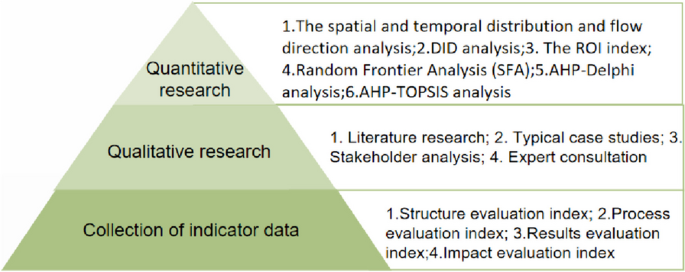
Catch-up on the research into D2H
-
1.
Collection of indicator data
For both the qualitative and quantitative evaluation of D2H schemes, the evaluation criteria should be set, which involves detailed data. We need well-structured evaluation index (population, economy, social environment, project schedule, budget, etc.), process evaluation index (D2H-generated fund distribution, specific implementation process, etc.), results evaluation index (death, composite health evaluation index, health service utilization index, etc.), impact evaluation index (Gini coefficient, healthcare access and quality index, international health regulation index, infant survival rate [27], cost-effectiveness analysis, etc.). It is worth noting that data collected varies between different D2H schemes.
-
2.
Qualitative research
Literature research method is crucial for the development of D2H analysis. At present, the research results on D2H financing mode, operation mechanism, applicable scenarios and conditions, key stakeholders, effects and effects are all based on content analysis, expert consultation, swot analysis and bibliometric analysis. Qualitative research can help to clarify problems by drawing on the hands-on experience and feedback from different stakeholders and lay the ground for the subsequent quantitative research.
-
3.
Quantitative research
In general, D2H is a policy-based approach involving various parties. The scale of funding, measurable SOPs, and impact are the focal areas of quantitative analysis.
The traditional analytical methods are described as follows: As for funds, the spatial and temporal distribution and flow direction analysis can be used on the basis of detailed data [28]. Regarding the D2H item effect, we can perform the DID analysis through the time breakpoints.
Non-traditional analysis can be as follows: In the face of the economic attributes of the decision on D2H, the ROI index can be used to evaluate benefits, and make the next budget planning and strategy formulation [29]. Random Frontier Analysis (SFA) is used to estimate the technical efficiency score of health systems. We can specify a regression model to evaluate the effectiveness of creditor countries’ investment in technology efficiency [30]. But in order to study D2H more thoroughly, combined qutlitative evaluation methods need to be applied. For example, AHP-Delphi analysis is used to screen the indicators, determine the index system and give weight. AHP-TOPSIS analysis method is to determine the fit of the evaluation object between the positive and negative ideal solutions to determine the optimal evaluation between multiple experts [31, 32].
More importantly, it is desirable to screen out the outcome indicators that can well evaluate the impact of D2H, which is of great benefit to the econometric analysis of the influencing factors of the panel data and contributes to the development of future schemes. Of course, attention should be paid to the fact that the outcome evaluation indicators of different projects vary greatly and will be customized.
link






